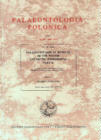| PALAEONTOLOGIA POLONICA VOL. 64 | |
 |
Editor: Jerzy Dzik Assistant editor: Wojciech Majewski |
JERZY
DZIK and TOMASZ SULEJ |
|
Dzik,
J. and Sulej, T. 2007. A review of the early Late Triassic
Krasiejów biota from Silesia, Poland. Palaeontologia Polonica
64, 3-27. Abstract:
Mass accumulations of vertebrate fossils in the tetrapod
“graveyard” at Krasiejów near Opole, SW Poland, occur
in a vast lacustrine marly claystone horizon and claystone lenses of
various extent within fluviatile cross-laminated mudstone. These
fossil assemblages do not differ from each other in taxonomic
composition, but the proportions of aquatic to land animals are
dramatically different. We attempted to separate these two
components of the assemblages to restore the original composition of
the biota. The lacustrine biocoenosis component of Krasiejów
includes characean algae, various molluscs and arthropods, ganoid
and dipnoan fishes, the phytosaur Paleorhinus, and the
temnospondyl amphibian Metoposaurus as the most common
vertebrate. The capitosaurid labyrinthodont Cyclotosaurus
probably occupied the lake shore. The inland vertebrate community
was dominated by the herbivorous aetosaur Stagonolepis and
the small herbivorous dinosaur Silesaurus, which probably
were the prey for the rauisuchian Teratosaurus. The
geological age of the Krasiejów strata can be determined, although
with a rather low resolution, based on position of various members
of its fauna in their evolutionary lineages. Biostratigraphic and
sequence stratigraphy evidence may improve the precision of this
dating. The strata seem to correspond with the upper part of the
Weser Formation in Germany, believed to be of Late Carnian age. Key
words: Germanic Basin, Keuper, Carnian, flora, archosaurs, dinosaurs,
stratigraphy.
Received 23 August 2007, accepted 15 October 2007 |
TOMASZ
SULEJ |
|
Sulej, T. 2007. Osteology, variability, and evolution of Metoposaurus, a
temnospondyl from the Late Triassic of Poland. Palaeontologia
Polonica 64, 29–139. Abstract: A new reconstruction of the whole skeleton of the
Carnian temnospondyl Metoposaurus diagnosticus krasiejowensis is
presented with a detailed description of skeletal elements and their
variability. The rigid construction of the vertebral column and limb
articulations suggest that the metoposaurs used their limbs as flippers
and swam by symmetrical and simultaneous movements of the limbs, like
the plesiosaurs. The dentigerous ossicles are for the first time
identified in metoposaurs. The Meckelian cartilage allowed for rotation
of the mandible rami while opening the mouth. The osteological
variability of Metoposaurus reveals allometry in growth of adult
specimens. A possible role of natural selection in controlling the
decrease of the variability during ontogeny of the metoposaur is
inferred. Close relationship of the Metoposauridae and the Brachyopoidea
is supported, contrary to their alleged trematosaurid origin. Two
evolutionary lineages of the metoposaurids are distinguished based on
metrics of cranial and postcranial elements. In the lineages with the
lacrimal excluded from orbital margin, there is a tendency to decrease
the depth of the otic notch and to decrease body-size. In the lineage in
which the lacrimal forms part of the orbit margins, there is a tendency
to elongation of the posterior part of the interclavicle and to diminish
the central area with polygonal pits of the interclavicle. The decrease
in ossification of the braincase, and gracilization of the humerus,
scapula, and fibula may be an adaptation to the aquatic life. These
changes were connected with the neotenous origin of the metoposaurids.
Both lineages evolved mostly by extension of the ontogeny, possibly
reactivating silenced developmental programmes. Key words: Metoposauridae, ontogeny, allometry, anatomy, autecology,
locomotion, canalization. Tomasz
Sulej sulej@twarda.pan.pl,
Instytut Paleobiologii PAN, Twarda 51/55, PL-00-818 Warszawa, Poland. Received 7
October 2006, accepted 10 March 2007
|
Home | Editors | Current Issue | Archive | Instructions | Subscription | History | Institute of Paleobiologyy |
|
| ©
1997-2007. Instytut Paleobiologii PAN Web Site Design by Jarosław Stolarski Last updated 07-12-13 |
Best
viewed by Internet Exlorer 4.x or higher and |